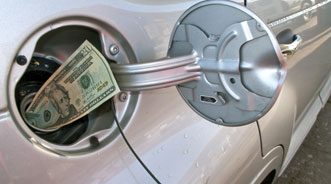Low Supply Tempers Impact of Fuel Costs on Used SUV Prices

By subscribing, you agree to receive communications from Auto Remarketing and our partners in accordance with our Privacy Policy. We may share your information with select partners and sponsors who may contact you about their products and services. You may unsubscribe at any time.
McLEAN, Va. –
It likely doesn’t come as a surprise that $4 per gallon gas would have strong downward impact on the used values of large SUVs. Interestingly enough, though, a white paper from the National Automobile Dealers Association suggests that short supply of these units greatly mitigates the used value swoons caused by surging costs at the pump.
“In short, the limited supply of large SUVs will keep prices firm despite higher gasoline prices,” NADA explained.
NADA illustrates this in further detail through a chart of its 2012 forecast for large SUV prices. It includes a month-by-month look from March through December, with each month’s prices of one- to five-year-old large SUVs being compared to what the price was in February.
Each month includes two scenarios: one where the low supply of large SUVs is not taken into consideration; and one where it is.
“In the first scenario, we see that the negative effect of $4-per-gallon gasoline will drive down the price of large SUVs by 5.3 percent at the lowest point in the year (November),” analysts stated. “Results are dramatically different when we factor in the estimated 23-percent annual decline in used large SUV supply.
“Scenario two then, shows prices falling by a mild 1.5 percent at the lowest point in the year,” they added. “Moreover, the supply lift improves as the year progresses because used volume for the segment will continue to wane well into 2013.”
Subscribe to Auto Remarketing to stay informed and stay ahead.
By subscribing, you agree to receive communications from Auto Remarketing and our partners in accordance with our Privacy Policy. We may share your information with select partners and sponsors who may contact you about their products and services. You may unsubscribe at any time.
Pricing Impact for Hybrids
On the opposite side of the fuel-consumption spectrum, NADA Used Car Guide took a look at pricing in two hybrid compact cars (Honda Civic hybrid and the Toyota Prius) during gas-price spikes and compared them to those for gas-only compacts.
What NADA UCG found is that in the most recent fuel-price surge, the increase in used hybrid prices has been “muted” compared to prior run-ups in fuel costs.
For instance, when gas prices climbed $1.02 /gallon from January 2008 throughJuly 2008, the Civic hybrid and Prius showed a 37-percent uptick in used prices. Conversely, there was just a 22-percent hike for gas-only models, according to NADA UCG.
And then when fuel costs went up $0.81/gallon from January 2011 through May 2011, the two hybrids jumped 41 percent in price, with gas-only compacts jumping 27 percent.
“This year things have played out a bit differently,” said executive automotive analyst Jonathan Banks. “The $0.52 increase in the price of gasoline since the start of the year has once again pressured up used prices for all compact cars — hybrid or otherwise — well beyond the seasonal lift normally associated with the time of the year.
“Through April, gas-only compact car prices have in-creased by 16 percent, while hybrid prices have grown by 17 percent,” Banks continued. “Although non-hybrid growth is averaging nine points back of the appreciation witnessed during the gas spikes of ’08 and ’11, this figure pales in comparison to the 22 point difference for hybrid models.”
So what are the likely reasons for this change? The analysis first pointed to the improvements made by today’s gas-only rides when it comes to fuel efficiency.
One example the report gives is the 2012 Ford Focus, whose fuel economy is 11 percent stronger than its 2008 edition. Likewise, the 2012 Civic (non-hybrid) has 10-percent stronger fuel efficiency than the 2008 variety, the analysis notes.
What’s more, there was an 18-percent fuel-economy improvement between the 2008 and 2012 versions of the Hyundai Elantra.
Looking at hybrids, there was a 9-percent improvement in the fuel economy between the 2008 and 2012 editions of the Toyota Prius, with the 2012 Civic hybrid showing just a 5-percent gain over its 2008 model.
“Perhaps more significantly, as gasoline prices dip, demand for hybrids tends to plummet well beyond the slow-down in demand witnessed on gas-only versions,” Banks stated. “As a result, hybrid prices have been more volatile through periods of rapidly changing gasoline prices.
“While this increases the opportunity associated with buying when the market is at a low point, it also increases the risk associated with buying when prices are at their highest,” he added.
An example of this is the Prius. During last year’s price hike in the first four months of the year, there was close to a $4,500 uptick in prices for the vehicle.
However, Banks pointed out, “fast forward to the fall and prices for the same Prius had dropped by $4,800.”
He continued: “Considering gas engine efficiency advancements combined with the still-fresh memories of last year, it’s not surprising to see dealers and consumers alike showing more restraint in their demand for compact hybrid cars.
“With year-to-date price growth averaging over $2,400 or 55 percent less than what was seen last year, these factors have already worked to reduce hybrid price volatility and the associated risk through this year’s gasoline price surge,” Banks added, then adding a bit of a caveat.
“That said, because hybrid prices have increased by two points more than those of gas-only compacts through April, NADA still expects a steeper drop once prices start to regress through the summer and into the fall.”


